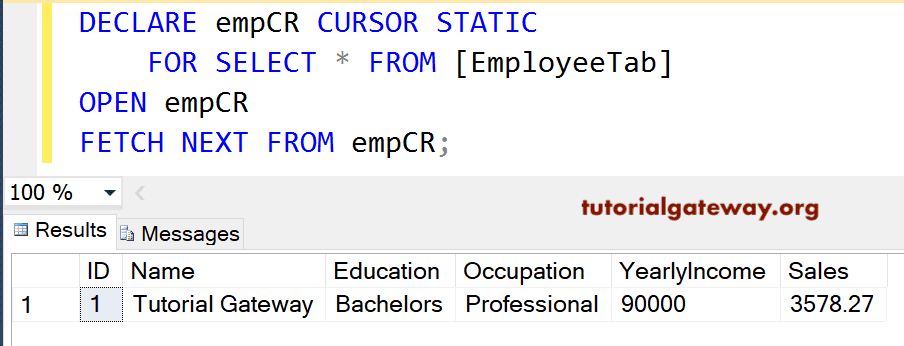
The following example declares a simple cursor for the rows in the Person. Person table with a last name that starts with B, and uses FETCH NEXT to step through the rows. The FETCH statements return the value for the column specified in DECLARE CURSOR as a single-row result set. The purpose of using a cursor, in most cases, is to retrieve the rows from your cursor so that some type of operation can be performed on the data. OFFSET and FETCH NEXT are similar to TOP, but I believe they are more powerful.
A fetch statement retrieves rows one at a time from the result set of a multi-row query - in other words it advances the cursor to the next row. It can return zero, one, or multiple rows and assigns the values of the rows to variables if. The next operation – Top, limits those rows to the last 10. Does it perform well in that version?
SELECT statement returns a set of rows which is called a result set. However, sometimes, you may want to process a data set on a row by row basis. SQL works based on set e. This is where cursors come into play. Ask Question Asked years, months ago.
You can fetch rows one at a time, several at a time, or all at once. The data is stored in variables or fields that correspond to the columns selected by the query. To limit the number of rows returned by a query, you often use the LIMIT clause. The LIMIT clause is widely used by many relational database management systems such as MySQL, H and HSQLDB. The WITH HOLD addition in the OPEN CURSOR statement allows you to prevent a cursor from being closed when a database commit occurs in Native SQL.
An open cursor is linked to a multiple-line selection in the database table. If a row exists, the fetched columns are stored in the named variables. Why does FETCH NEXT return second row after opening cursor ? Active years, months ago. Hello, I have searched the net for an answer but could not find one. When I declare a table variable and then try to insert fetched row into the table variable like.

Beispiel für einen Cursor, der alle Zeilen nach Index für jede Datenbank abfragt. More than years have passed since last update. After declaring and opening your cursor, the next step is to use the FETCH statement to fetch rows from your cursor.
How can I get the result of a cursor fetch in a table? I understand that I can declare two variables and store the individually. But for a table with many columns that would. This form of fetch is abbreviated.
Here is the full fetch command.
Keine Kommentare:
Kommentar veröffentlichen
Hinweis: Nur ein Mitglied dieses Blogs kann Kommentare posten.